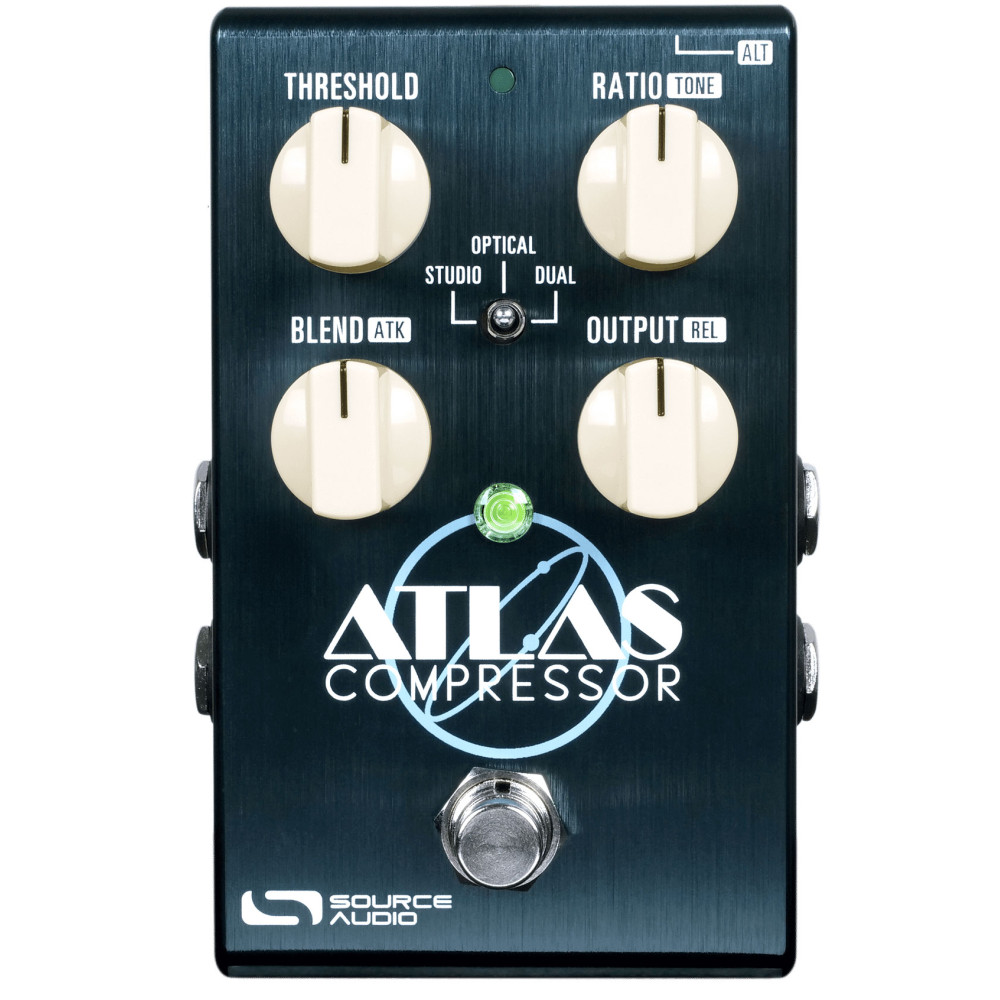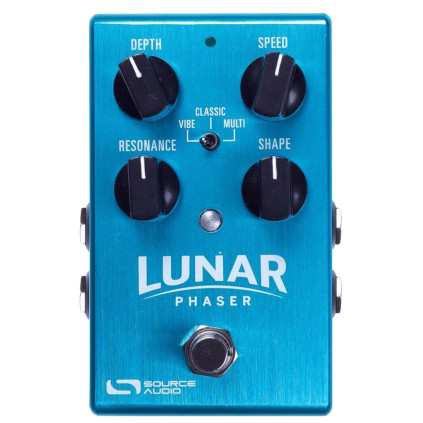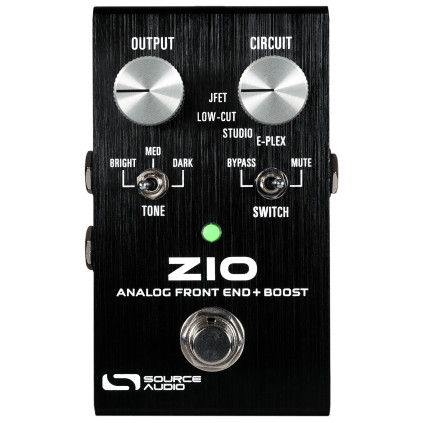Kompressorpedal for gitar og bass med 6 kompresjonsstiler, stereo I/O, noisegate og EQ
Atlas Kompressor gir deg en omfattende samling av kompresjonskretser som gjenskaper den klassiske tonen og følelsen fra bransjens mest ettertraktede kompressorer. Rett ut av esken leverer Atlas seks forskjellige kompresjonsstiler, fra klassiske stompbox-kompressorer som den utgåtte Diamond Optical Compressor til high-end rack-enheter som den raske 1176 kompressoren og den myke og jevne LA2A optiske kompressoren. Atlas har også avansert to-bånds kompresjon, som gir uavhengige kontroller for både høy- og lavfrekvenser. Hver kompresjonsmotor har innebygde kontroller for terskel, ratio, attack, release, output, tone og blend, slik at du kan finjustere hver parameter på det kompakte One Series-kabinettet.
En kompresjonshistorie Atlas er proppfull av ulike kompresjonstyper og kan være en reise gjennom kompresjonens historie. Første stopp: klassiske stompbox-kompressorer som den legendariske Dan Armstrong Orange Squeezer og den fremragende (men utgåtte) Diamond Compressor. Neste stopp: universelt anerkjent studioutstyr som den myke LA2A optiske kompressoren og den ultraresponsive 1176 FET-kompressoren. Til slutt går vi dypere inn i teknologien med Peak, RMS, VCA, og dobbel kompresjon, samt en innebygd expander-krets – Atlas har alt og leverer på toppnivå.
OPTICAL RACK Optical Rack-kompressormotoren er basert på de legendariske LA2A studiooptokompressorene fra tidlig 60-tall. Disse enhetene kontrollerte utgangsnivået ved hjelp av lys, og resulterte i en veldig jevn og myk attack, som gir en fyldig og naturlig lyd på gitar, bass eller vokal. Perfekt for rene gitartoner og akustiske gitarer.
STUDIO 76 Studio 76-kompressoren er inspirert av 1176 studio rack-kompressorene fra slutten av 60-tallet og tidlig 70-tall, kjent for sin fulle kropp og superraske attack. Dette er et godt valg for rask og aggressiv spilling, som country-picking, slap-bass og slide-gitar.
CUBIC ZIRCONIA Cubic Zirconia er inspirert av optokompressorer som bruker LED som lyskilde, noe som gir raskere attack- og release-tider og en mer "skitten" lyd – perfekt for stramme og funky gitarriff.
STUDIO SNAP En svært aggressiv og moderne kompressor basert på VCA-kompresjon, som bruker både RMS og Peak-kontroll. Dette gir Studio Snap sin unike karakter.
DOBBELBÅNDET Atlas har to uavhengige kompressorer som kan kjøres i serie, parallelt eller i band-split-modus. Den høye frekvensen slipper raskere, mens den lave holder på kompresjonen lengre, noe som gir en vakker blomstrende effekt på høye harmonier – perfekt for lange sustain-noter og ringing akkorder.
Bassoptimaliseringsmodus Med et enkelt knappetrykk kan du konvertere alle de seks forhåndsinnstilte kompressorene i Atlas til bass-spesifikke kompresjonsmotorer, optimalisert for den lavere dynamikken og attack-egenskapene til bassgitar.
Detaljert redigering med Neuro Koble Atlas til Neuro-appene for mobil eller desktop for avansert kompressorredigering med sanntidsoversikt over signalreduksjon, justering av Look Ahead-kompresjon, Soft Knee-kontroll, Auto Makeup Gain, 8-bånds grafisk EQ og mer.
Funksjoner:
- Seks ulike kompresjonsstiler inspirert av studioutstyr og klassiske pedaler
- LA2A Optisk kompresjon for en varm, jevn lyd
- 1176 FET-kompressor for rask attack og fyldig tone
- LED optisk kompressor for en raskere, mer "skitten" respons
- Dobbel kompresjon med separate kontroller for høy- og lavfrekvenser
- Avanserte kontroller som terskel, ratio, attack, release og tone
- Spesialtilpasset modus for bassgitar
- Gratis tilgang til Neuro-redigeringsverktøy for dypere effektkontroll
Neuro Editor Features:
Connect the Atlas Compressor to the Neuro Desktop Editor (a free download for Mac or Windows computers) or the Neuro Mobile App (free for iPhone and Android) and explore the power of effect downloading, customization, and sharing that comes with every One Series pedal.
- Growing Library of Published Presets: Quickly test and download sounds from the ever-expanding collection of published User Presets created by Source Audio and the rest of the Atlas Compressor/Neuro Editor Community.
- Deep Effects Editing Capabilities: Use the Neuro Desktop Editor (free download for Mac and Windows) or the Neuro Mobile App (free for iOS and Android) to create, store, and share highly customized filter effects.
- Dual Compressor: Use Atlas’ dual compressors in a variety of ways: in Series, Parallel, or Band Split mode, which provides a separate set of controls for both high and low frequencies.
- Dan Armstrong Orange Squeezer: A gritty compression inspired by the vintage 1970s unit that graced classic tracks like Steely Dan’s “Peg” and Dire Straits’ “Sultans of Swing.” Available in the Neuro Editor.
- Look Ahead Compression: A classic studio trick. When engaged, Look Ahead creates an imperceptible latency in the signal that “looks into the future” and allows for an extra quick and smooth attack that without any additional distortion or artifacts.
- Soft Knee:Adjusts the transition curve of the Threshold point. A sharper knee creates a snappy compression and a soft knee creates a more natural sounding compression.
- Side Chain Compression: Use the signal going to Input 2 to trigger the compression applied to the signal going into Input 1.
- Advanced Equalization: Use the 3-band parametric or 8-band graphic equalizers to tweak the tonal characteristics of your compression.
- USB Connection – Use the pedal’s mini USB port to connect Atlas to the Neuro Desktop Editor, which can be used to edit presets or download the latest pedal firmware.
MIDI Features:
The Atlas Compressor responds to MIDI Program Change (PC) and Continuous Controller (CC) messages via its mini USB port. The USB port handles communication between the Atlas and digital audio workstations (DAW) on Mac and Windows machines as well as external MIDI controllers with USB host support (we recommend the DMC.micro from Disaster Area Designs)
- Preset Saving – Save up to 128 effect presets.
- MIDI Mapping – Use the Neuro Desktop Editor to easily map MIDI Continuous Controller (CC) messages to a comprehensive list of parameters.
- Preset Recall - Use MIDI CC numbers 103 & 104 to recall any of the Spectrum's 128 MIDI accessible presets.
- The Neuro Hub - Connect the Spectrum to the Neuro Hub and use MIDI CC messages to control parameters or recall presets.
Note: As of Hub fw 1.18 and Spectrum fw 1.05, the Spectrum can now be added to scenene
Specifications:
- Includes 9v DC power supply (300mA / Negative Tip)
- Includes 1/8” to 1/4” cable for Neuro Mobile App connection.
- Power Consumption — 165mA
- USB port — Connects to Mac or Windows PC for firmware updates and the forthcoming in-depth effects editing software.
- Brushed anodized aluminum housing.
- Dimensions: L: 4.5 in./11.4cm x W: 2.75 in./7cm x H: 2 in./5.1cm (including knobs)



































